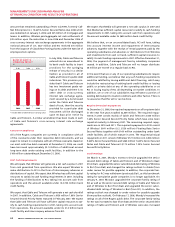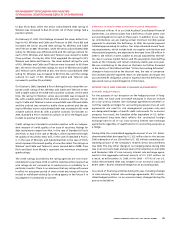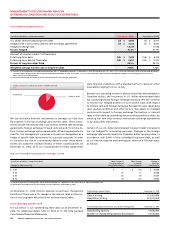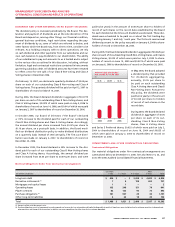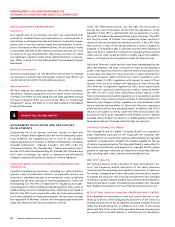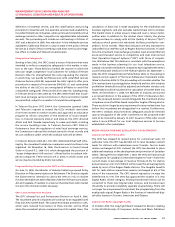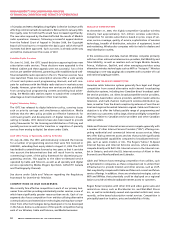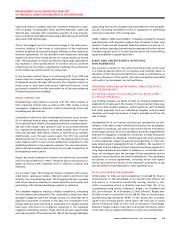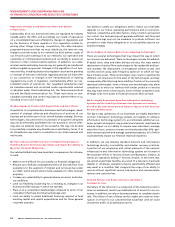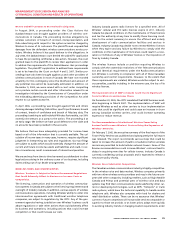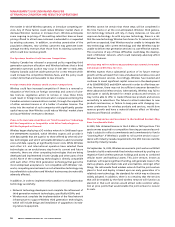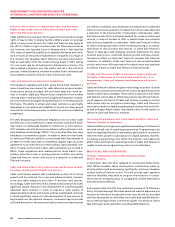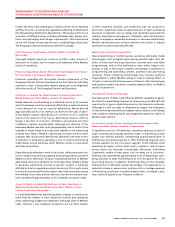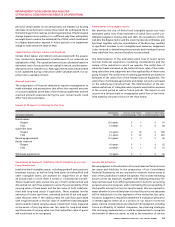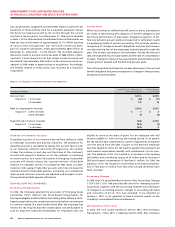Rogers 2006 Annual Report Download - page 58
Download and view the complete annual report
Please find page 58 of the 2006 Rogers annual report below. You can navigate through the pages in the report by either clicking on the pages listed below, or by using the keyword search tool below to find specific information within the annual report.
54 R OGE RS COM MUN I C ATIO NS I NC . 2 0 0 6 AN NUAL R EPO R T
MANAGEMENT’S DISCUSSION AND ANALYSIS
OF FINANCIAL CONDITION AND RESULTS OF OPERATIONS
Regulatory Changes Could Adversely Affect O ur Results
of Operation s.
Substantially all of our business activities are regulated by Industry
Canada and/or the CRTC, and accordingly our results of operations
on a consolidated basis are affected by changes in regulations and
by the decisions of these regulators. This regulation relates to,
among other things, licencing, competition, the cable television
programming services that we must distribute, the rates we may
charge to provide access to our network by third parties, resale of
our networks and roaming on to our networks, our operation and
ownership of communications systems and our ability to acquire an
interest in other communications systems. In addition, our cable,
wireless and broadcasting licences may not generally be transferred
without regulatory approval. Changes in the regulation of our busi-
ness activities, including decisions by regulators (such as the granting
or renewal of licences or decisions regarding services we must offer
to our customers), or changes in the interpretations of existing
regulations by courts or regulators, could adversely affect our con-
solidated results of operations. Our regulated subsidiaries must
be Canadian-owned and controlled under requirements enacted
or adopted under the Broadcasting Act, the Telecommunications
Act and the Radiocommunication Act. These restrictions on non-
Canadian ownership and control may have an adverse effect on us,
including on our cost of capital.
We May Engage in U n successful Acquisitions and Divestitures.
Acquisitions of complementary businesses and technologies, devel-
opment of strategic alliances and divestitures of portions of our
business are an active part of our overall business strategy. Services,
technologies, key personnel or businesses of acquired companies
may not be effectively assimilated into our business or service offer-
ings and our alliances may not be successful. We may not be able
to successfully complete any divestitures on satisfactory terms, if at
all. Divestitures may result in a reduction in our total revenues and
net income.
We Have Substantial Debt and Interest Payment Requirement s
that May Restrict Our Future Operations and Impair Our Abilit y to
Meet Our Financial Obligations.
Our substantial debt may have important consequences. For instance,
it could:
• Make it more difficult for us to satisfy our financial obligations;
• Require us to dedicate a substantial portion of any cash flow from
operations to the payment of interest and principal due under
our debt, which would reduce funds available for other business
purposes;
• Increase our vulnerability to general adverse economic and indus-
try conditions;
• Limit our flexibility in planning for, or reacting to, changes in our
business and the industry in which we operate;
• Place us at a competitive disadvantage compared to some of our
competitors that have less financial leverage; and
• Limit our ability to obtain additional financing required to fund
working capital and capital expenditures and for other general
corporate purposes.
Our ability to satisfy our obligations and to reduce our total debt
depends on our future operating performance and on economic,
financial, competitive and other factors, many of which are beyond
our control. Our business may not generate sufficient cash flow and
future financings may not be available to provide sufficient net
proceeds to meet these obligations or to successfully execute our
business strategy.
We Are Subjec t to Various Risk s from Competing Technologies.
There are several technologies that may impact the way in which
our services are delivered. These technologies include broadband,
IP-based voice, data and video delivery services; the mass market
deployment of optical fibre technologies to the residential and busi-
ness markets; the deployment of broadband wireless access, and
wireless services using radio frequency spectrum to which we may
have limited access. These technologies may result in significantly
different cost structures for the users of the technologies, and may
consequently affect the long-term viability of certain of our currently
deployed technologies. Some of these new technologies may allow
competitors to enter our markets with similar products or services
that may have lower cost structures. Some of these competitors may
be larger with more access to financial resources than we have.
We Are Highly Dependent Upon Our Information Technology
Systems and the Inability to Enhance Our Systems or a Security
Breach or Disaster Could Have an Adverse Impact o n Our Financial
Results and Operations.
The day-to-day operations of our businesses are highly dependent
on their information technology systems. An inability to enhance
information technology systems to accommodate additional cus-
tomer growth and support new products and services could have an
adverse impact on our ability to acquire new subscribers, manage
subscriber churn, produce accurate and timely subscriber bills, gen-
erate revenue growth and manage operating expenses, all of which
could adversely impact our financial results and position.
In addition, we use industry standard network and information
technology security, survivability and disaster recovery practices.
A portion of our employees and critical elements of the network
infrastructure and information technology systems are located at
the corporate offices in Toronto, Ontario and Brampton, Ontario, as
well as an operations facility in Toronto, Ontario. In the event that
we cannot access these facilities, as a result of a natural or manmade
disaster or otherwise, operations may be significantly affected and
may result in a condition that is beyond the scope of our ability to
recover without significant service interruption and commensurate
revenue and customer loss.
Net work Failures Can Reduce Revenue and I mpact
Customer Service.
The failure of the network or a component of the network would, in
some circumstances, result in an indefinite loss of service for our cus-
tomers. In addition, we rely on business partners to complete certain
calls. The failure of one of these carriers might also cause an inter-
ruption in service for our customers that would last until we could
reroute the traffic to an alternative carrier.


